CRM System: Implications, Selection, and Implementation Overview
VerifiedAdded on 2021/04/16
|12
|1696
|38
Presentation
AI Summary
This presentation provides a comprehensive overview of Customer Relationship Management (CRM) systems. It begins by defining CRM and CRM systems, emphasizing their role in enhancing customer focus and retention in a competitive market. The presentation delves into the implications of CRM systems, including managing customer data, organizing interactions, tracking customer behavior, reducing business risks, measuring campaign success, providing instant metrics, managing customer service requests, and identifying industry trends. It then explores the selection and implementation process, covering CRM review, project management, vendor contracting, and training. The presentation identifies industries that can benefit from CRM, such as professional services, manufacturing, B2B companies, and hospitality, justifying the use of CRM in each. The presentation concludes by highlighting the impact of CRM on customer relationship building and the ability of businesses to adapt to industry changes, enabling more customized services. The presentation also includes a bibliography with relevant sources.
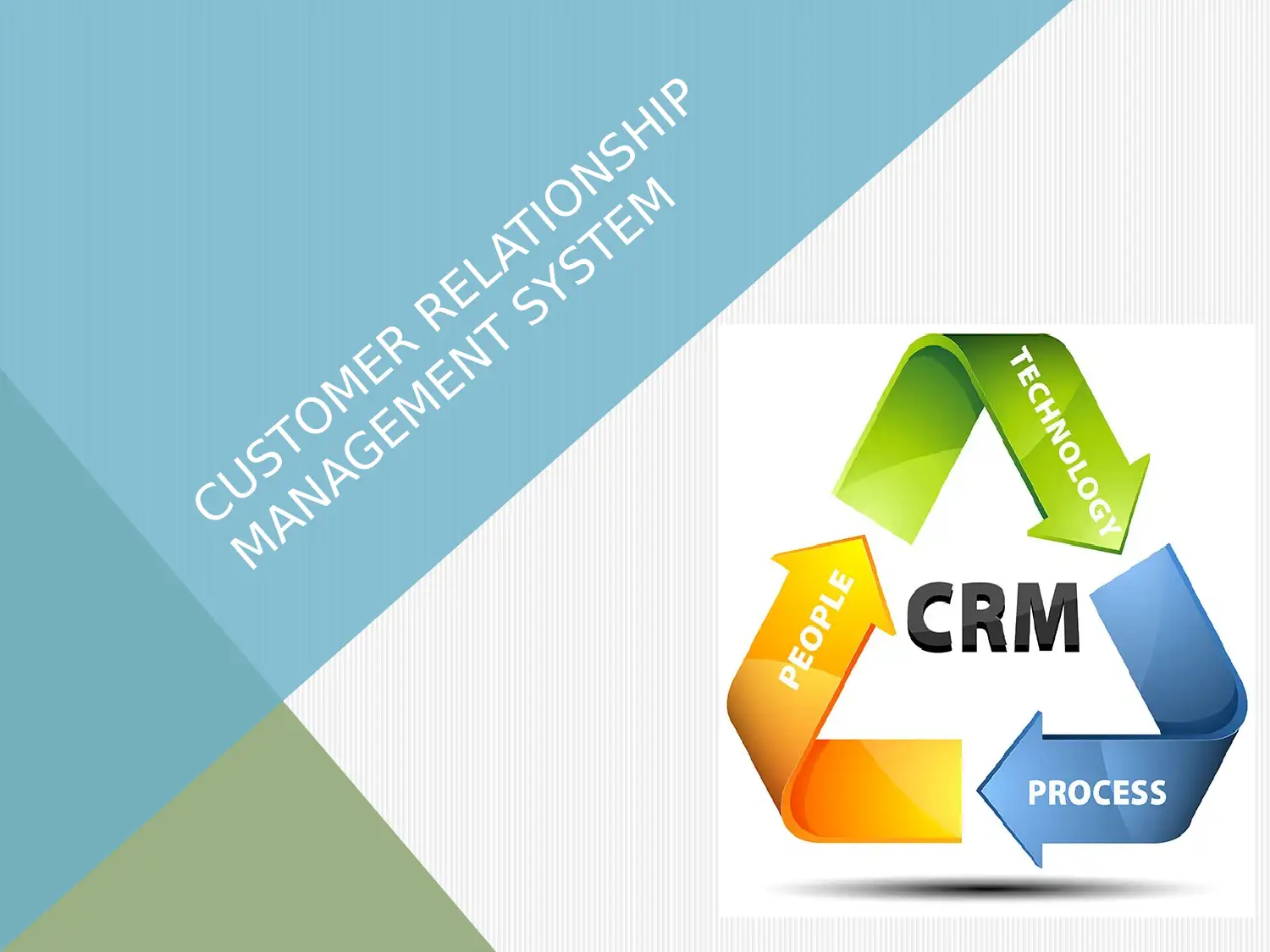
CUSTOMER RELATIONSHIP
MANAGEMENT SYSTEM
MANAGEMENT SYSTEM
Paraphrase This Document
Need a fresh take? Get an instant paraphrase of this document with our AI Paraphraser
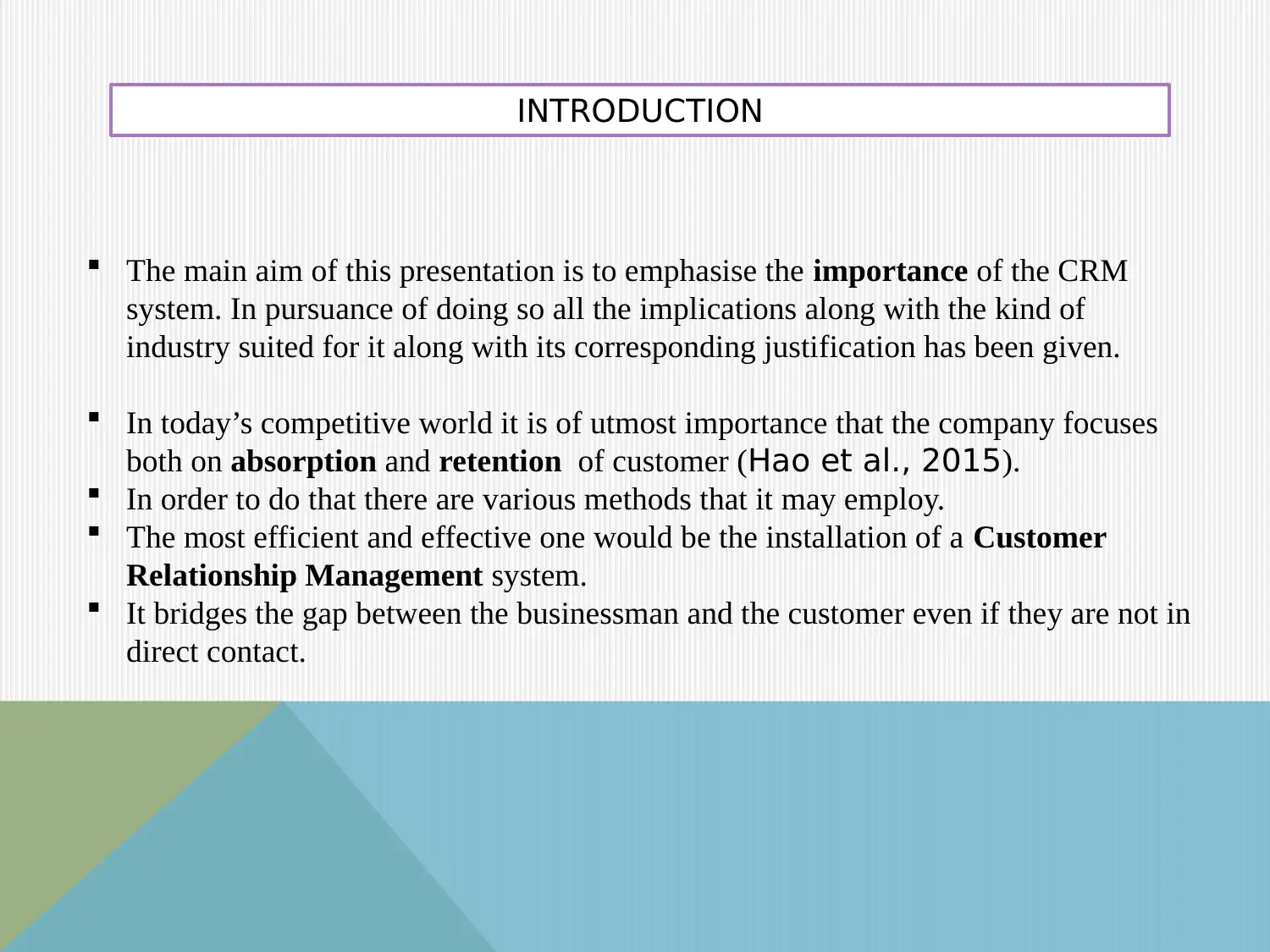
INTRODUCTION
The main aim of this presentation is to emphasise the importance of the CRM
system. In pursuance of doing so all the implications along with the kind of
industry suited for it along with its corresponding justification has been given.
In today’s competitive world it is of utmost importance that the company focuses
both on absorption and retention of customer (Hao et al., 2015).
In order to do that there are various methods that it may employ.
The most efficient and effective one would be the installation of a Customer
Relationship Management system.
It bridges the gap between the businessman and the customer even if they are not in
direct contact.
The main aim of this presentation is to emphasise the importance of the CRM
system. In pursuance of doing so all the implications along with the kind of
industry suited for it along with its corresponding justification has been given.
In today’s competitive world it is of utmost importance that the company focuses
both on absorption and retention of customer (Hao et al., 2015).
In order to do that there are various methods that it may employ.
The most efficient and effective one would be the installation of a Customer
Relationship Management system.
It bridges the gap between the businessman and the customer even if they are not in
direct contact.
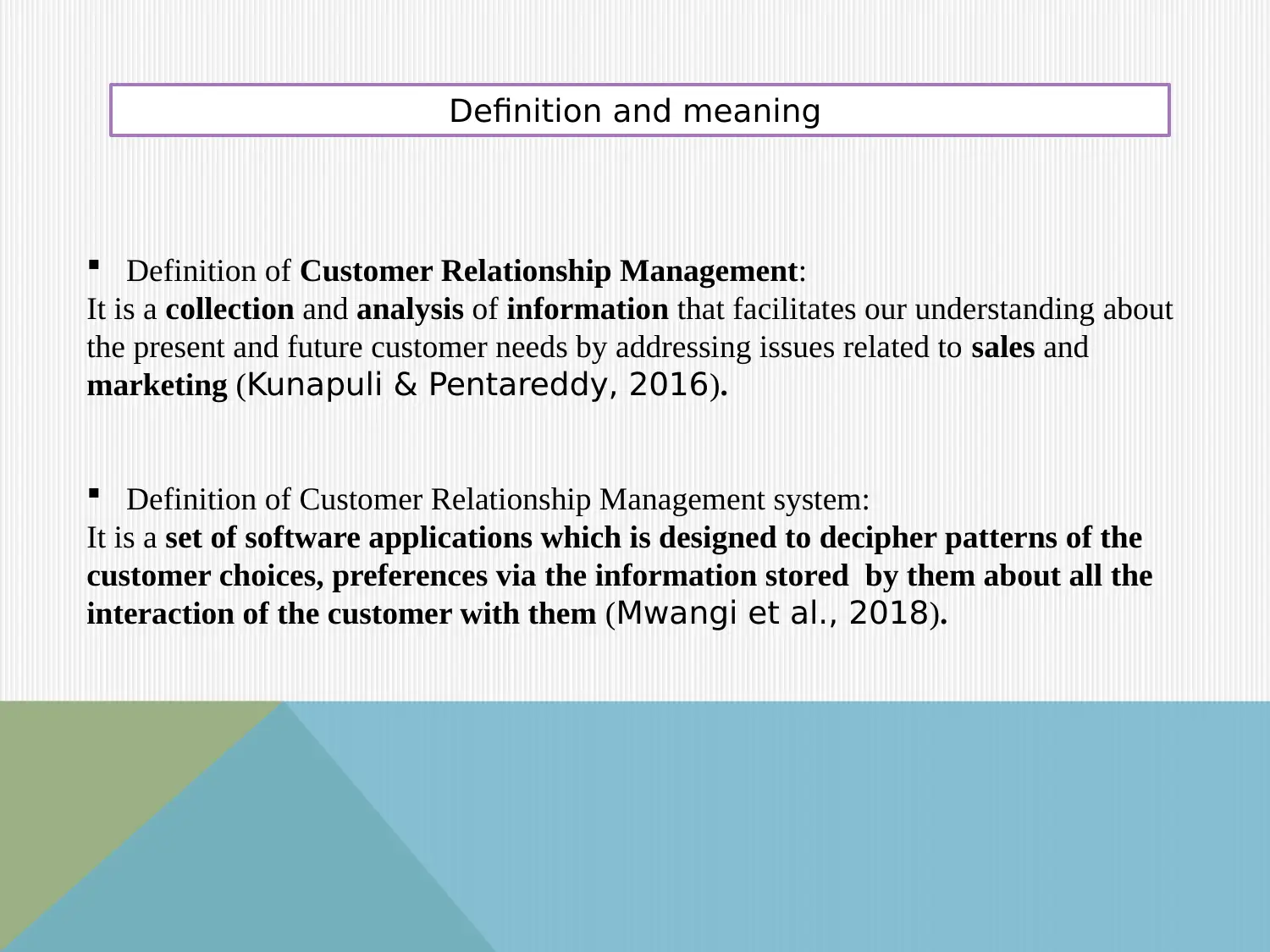
Definition and meaning
Definition of Customer Relationship Management:
It is a collection and analysis of information that facilitates our understanding about
the present and future customer needs by addressing issues related to sales and
marketing (Kunapuli & Pentareddy, 2016).
Definition of Customer Relationship Management system:
It is a set of software applications which is designed to decipher patterns of the
customer choices, preferences via the information stored by them about all the
interaction of the customer with them (Mwangi et al., 2018).
Definition of Customer Relationship Management:
It is a collection and analysis of information that facilitates our understanding about
the present and future customer needs by addressing issues related to sales and
marketing (Kunapuli & Pentareddy, 2016).
Definition of Customer Relationship Management system:
It is a set of software applications which is designed to decipher patterns of the
customer choices, preferences via the information stored by them about all the
interaction of the customer with them (Mwangi et al., 2018).
⊘ This is a preview!⊘
Do you want full access?
Subscribe today to unlock all pages.

Trusted by 1+ million students worldwide
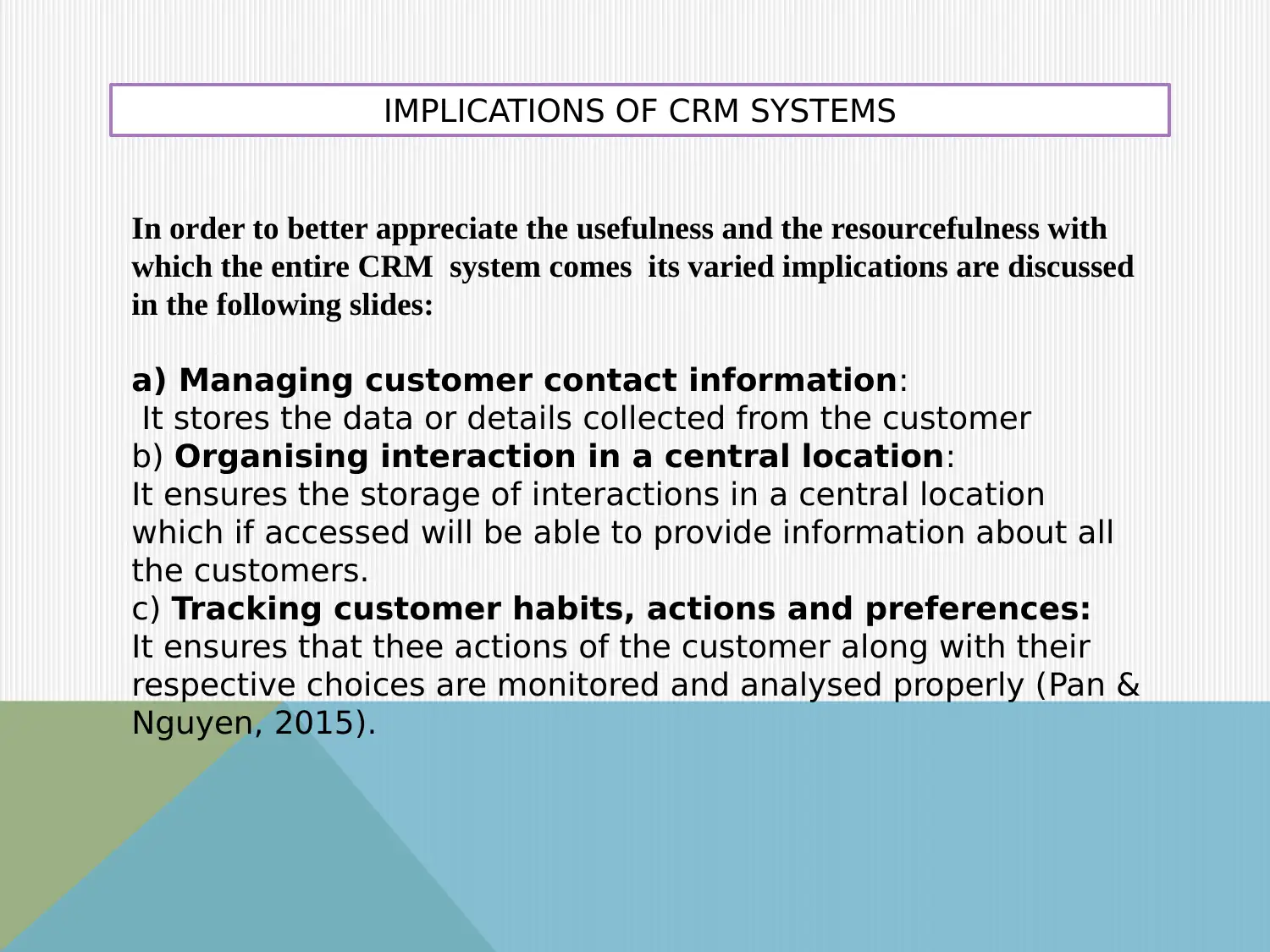
IMPLICATIONS OF CRM SYSTEMS
In order to better appreciate the usefulness and the resourcefulness with
which the entire CRM system comes its varied implications are discussed
in the following slides:
a) Managing customer contact information:
It stores the data or details collected from the customer
b) Organising interaction in a central location:
It ensures the storage of interactions in a central location
which if accessed will be able to provide information about all
the customers.
c) Tracking customer habits, actions and preferences:
It ensures that thee actions of the customer along with their
respective choices are monitored and analysed properly (Pan &
Nguyen, 2015).
In order to better appreciate the usefulness and the resourcefulness with
which the entire CRM system comes its varied implications are discussed
in the following slides:
a) Managing customer contact information:
It stores the data or details collected from the customer
b) Organising interaction in a central location:
It ensures the storage of interactions in a central location
which if accessed will be able to provide information about all
the customers.
c) Tracking customer habits, actions and preferences:
It ensures that thee actions of the customer along with their
respective choices are monitored and analysed properly (Pan &
Nguyen, 2015).
Paraphrase This Document
Need a fresh take? Get an instant paraphrase of this document with our AI Paraphraser
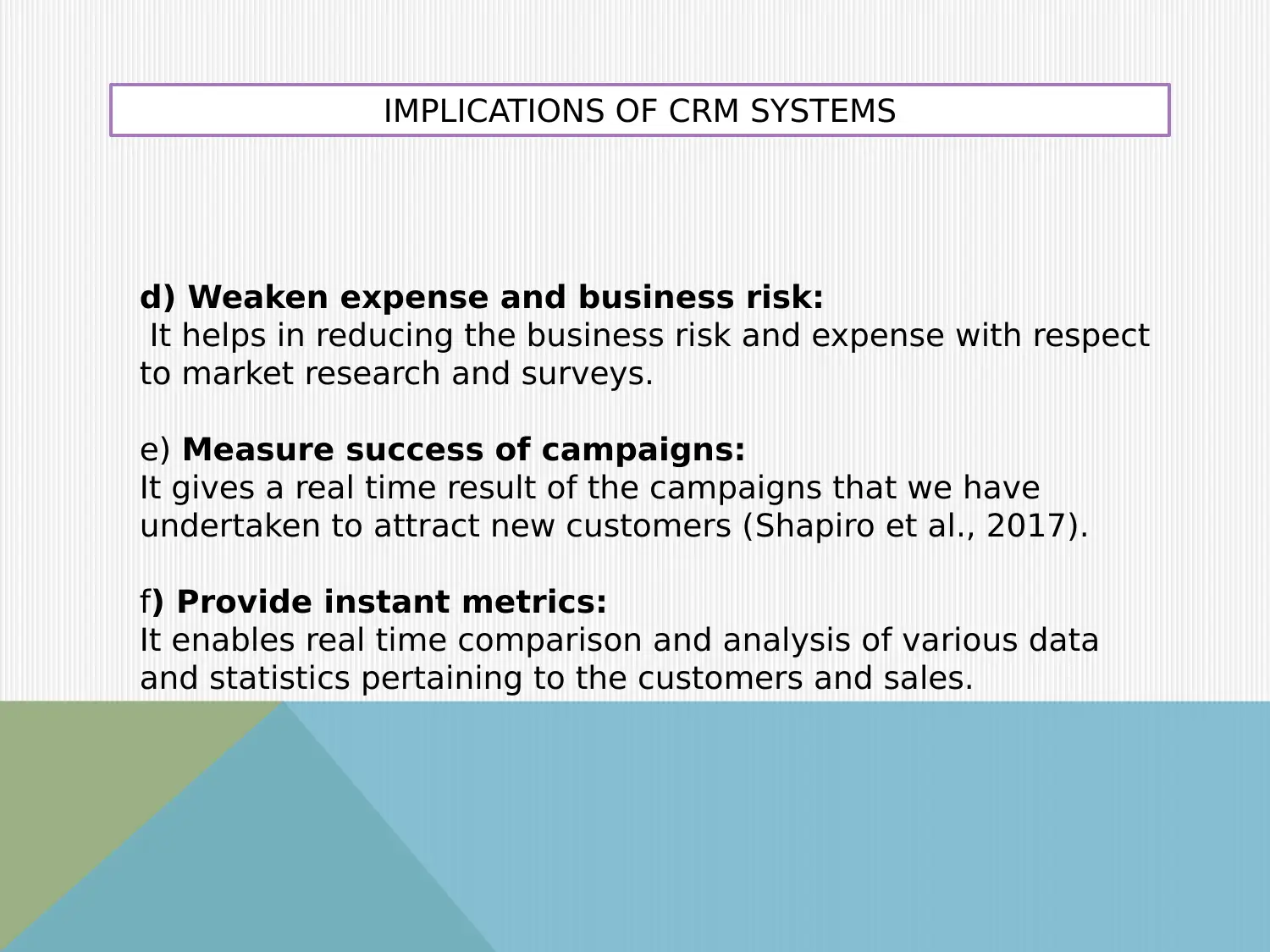
IMPLICATIONS OF CRM SYSTEMS
d) Weaken expense and business risk:
It helps in reducing the business risk and expense with respect
to market research and surveys.
e) Measure success of campaigns:
It gives a real time result of the campaigns that we have
undertaken to attract new customers (Shapiro et al., 2017).
f) Provide instant metrics:
It enables real time comparison and analysis of various data
and statistics pertaining to the customers and sales.
d) Weaken expense and business risk:
It helps in reducing the business risk and expense with respect
to market research and surveys.
e) Measure success of campaigns:
It gives a real time result of the campaigns that we have
undertaken to attract new customers (Shapiro et al., 2017).
f) Provide instant metrics:
It enables real time comparison and analysis of various data
and statistics pertaining to the customers and sales.
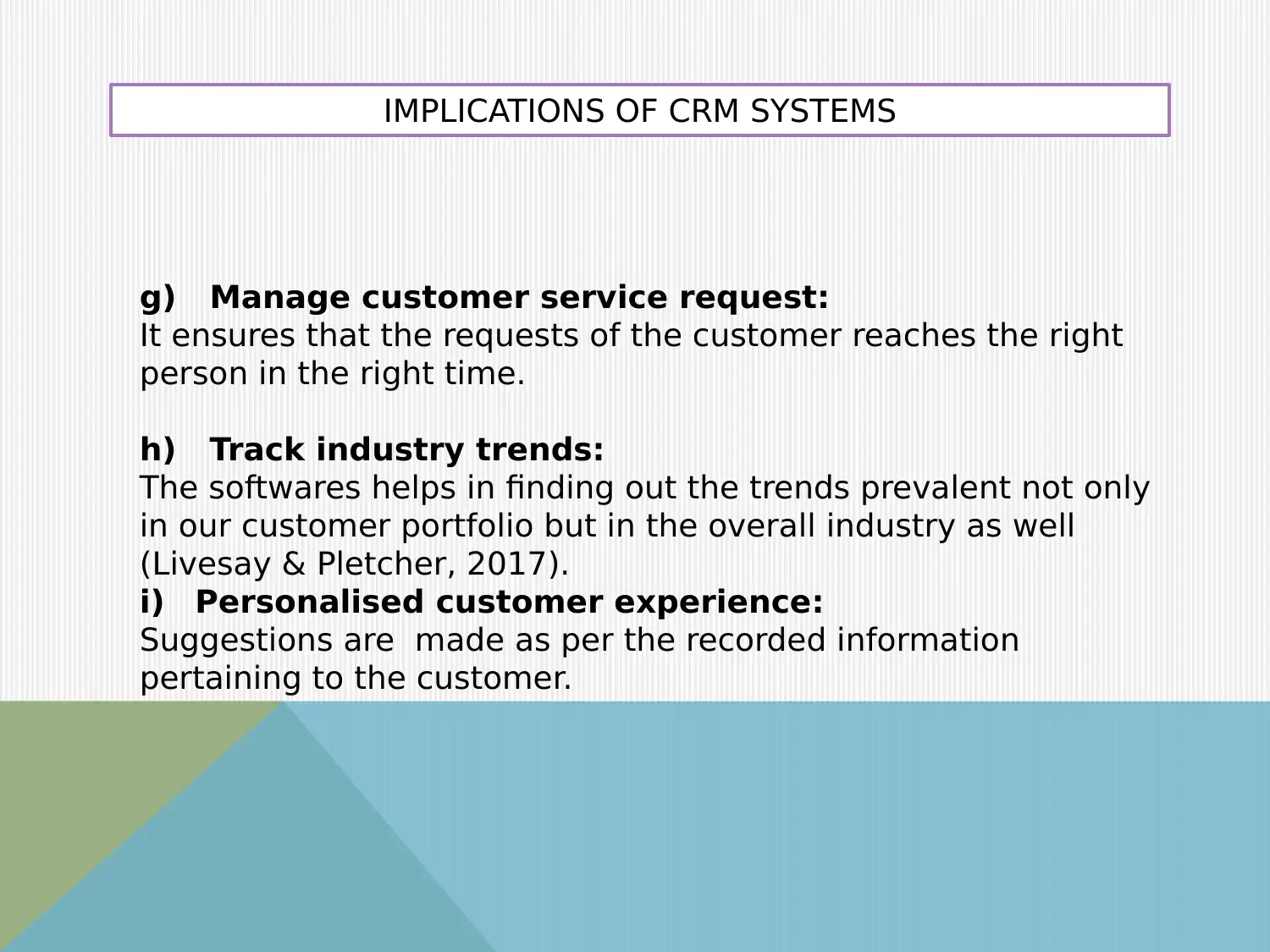
IMPLICATIONS OF CRM SYSTEMS
g) Manage customer service request:
It ensures that the requests of the customer reaches the right
person in the right time.
h) Track industry trends:
The softwares helps in finding out the trends prevalent not only
in our customer portfolio but in the overall industry as well
(Livesay & Pletcher, 2017).
i) Personalised customer experience:
Suggestions are made as per the recorded information
pertaining to the customer.
g) Manage customer service request:
It ensures that the requests of the customer reaches the right
person in the right time.
h) Track industry trends:
The softwares helps in finding out the trends prevalent not only
in our customer portfolio but in the overall industry as well
(Livesay & Pletcher, 2017).
i) Personalised customer experience:
Suggestions are made as per the recorded information
pertaining to the customer.
⊘ This is a preview!⊘
Do you want full access?
Subscribe today to unlock all pages.

Trusted by 1+ million students worldwide
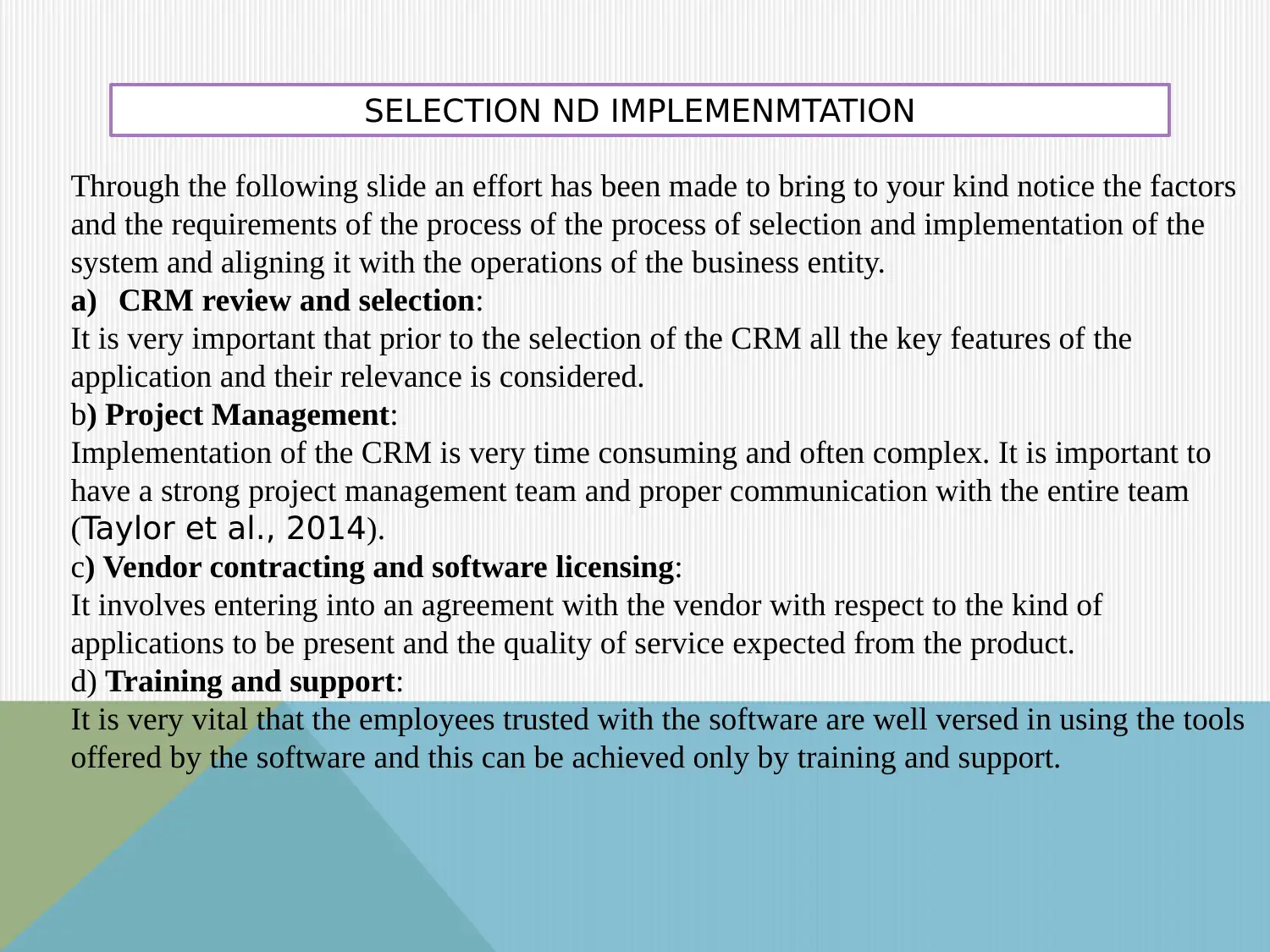
SELECTION ND IMPLEMENMTATION
Through the following slide an effort has been made to bring to your kind notice the factors
and the requirements of the process of the process of selection and implementation of the
system and aligning it with the operations of the business entity.
a) CRM review and selection:
It is very important that prior to the selection of the CRM all the key features of the
application and their relevance is considered.
b) Project Management:
Implementation of the CRM is very time consuming and often complex. It is important to
have a strong project management team and proper communication with the entire team
(Taylor et al., 2014).
c) Vendor contracting and software licensing:
It involves entering into an agreement with the vendor with respect to the kind of
applications to be present and the quality of service expected from the product.
d) Training and support:
It is very vital that the employees trusted with the software are well versed in using the tools
offered by the software and this can be achieved only by training and support.
Through the following slide an effort has been made to bring to your kind notice the factors
and the requirements of the process of the process of selection and implementation of the
system and aligning it with the operations of the business entity.
a) CRM review and selection:
It is very important that prior to the selection of the CRM all the key features of the
application and their relevance is considered.
b) Project Management:
Implementation of the CRM is very time consuming and often complex. It is important to
have a strong project management team and proper communication with the entire team
(Taylor et al., 2014).
c) Vendor contracting and software licensing:
It involves entering into an agreement with the vendor with respect to the kind of
applications to be present and the quality of service expected from the product.
d) Training and support:
It is very vital that the employees trusted with the software are well versed in using the tools
offered by the software and this can be achieved only by training and support.
Paraphrase This Document
Need a fresh take? Get an instant paraphrase of this document with our AI Paraphraser
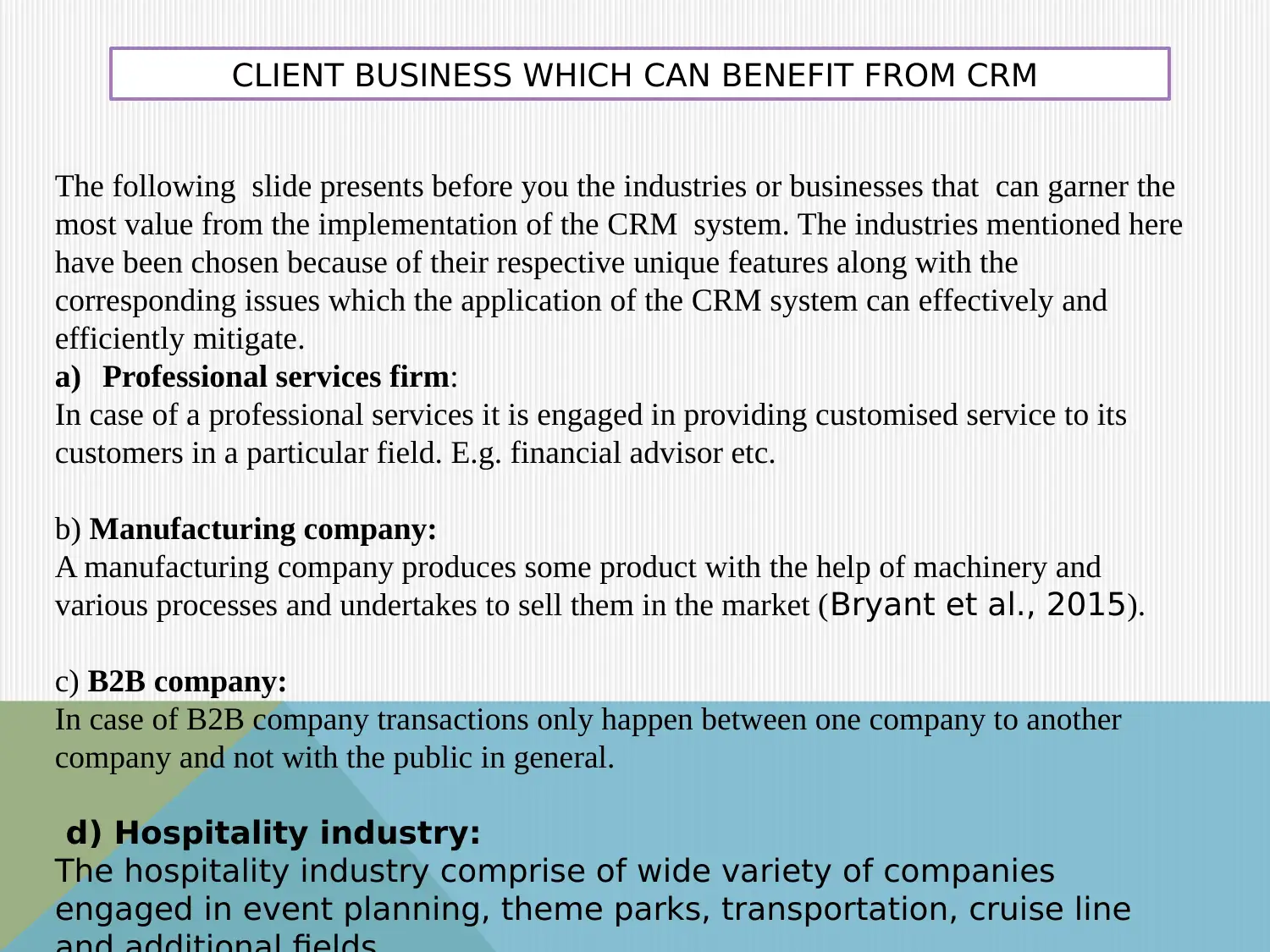
CLIENT BUSINESS WHICH CAN BENEFIT FROM CRM
The following slide presents before you the industries or businesses that can garner the
most value from the implementation of the CRM system. The industries mentioned here
have been chosen because of their respective unique features along with the
corresponding issues which the application of the CRM system can effectively and
efficiently mitigate.
a) Professional services firm:
In case of a professional services it is engaged in providing customised service to its
customers in a particular field. E.g. financial advisor etc.
b) Manufacturing company:
A manufacturing company produces some product with the help of machinery and
various processes and undertakes to sell them in the market (Bryant et al., 2015).
c) B2B company:
In case of B2B company transactions only happen between one company to another
company and not with the public in general.
d) Hospitality industry:
The hospitality industry comprise of wide variety of companies
engaged in event planning, theme parks, transportation, cruise line
The following slide presents before you the industries or businesses that can garner the
most value from the implementation of the CRM system. The industries mentioned here
have been chosen because of their respective unique features along with the
corresponding issues which the application of the CRM system can effectively and
efficiently mitigate.
a) Professional services firm:
In case of a professional services it is engaged in providing customised service to its
customers in a particular field. E.g. financial advisor etc.
b) Manufacturing company:
A manufacturing company produces some product with the help of machinery and
various processes and undertakes to sell them in the market (Bryant et al., 2015).
c) B2B company:
In case of B2B company transactions only happen between one company to another
company and not with the public in general.
d) Hospitality industry:
The hospitality industry comprise of wide variety of companies
engaged in event planning, theme parks, transportation, cruise line
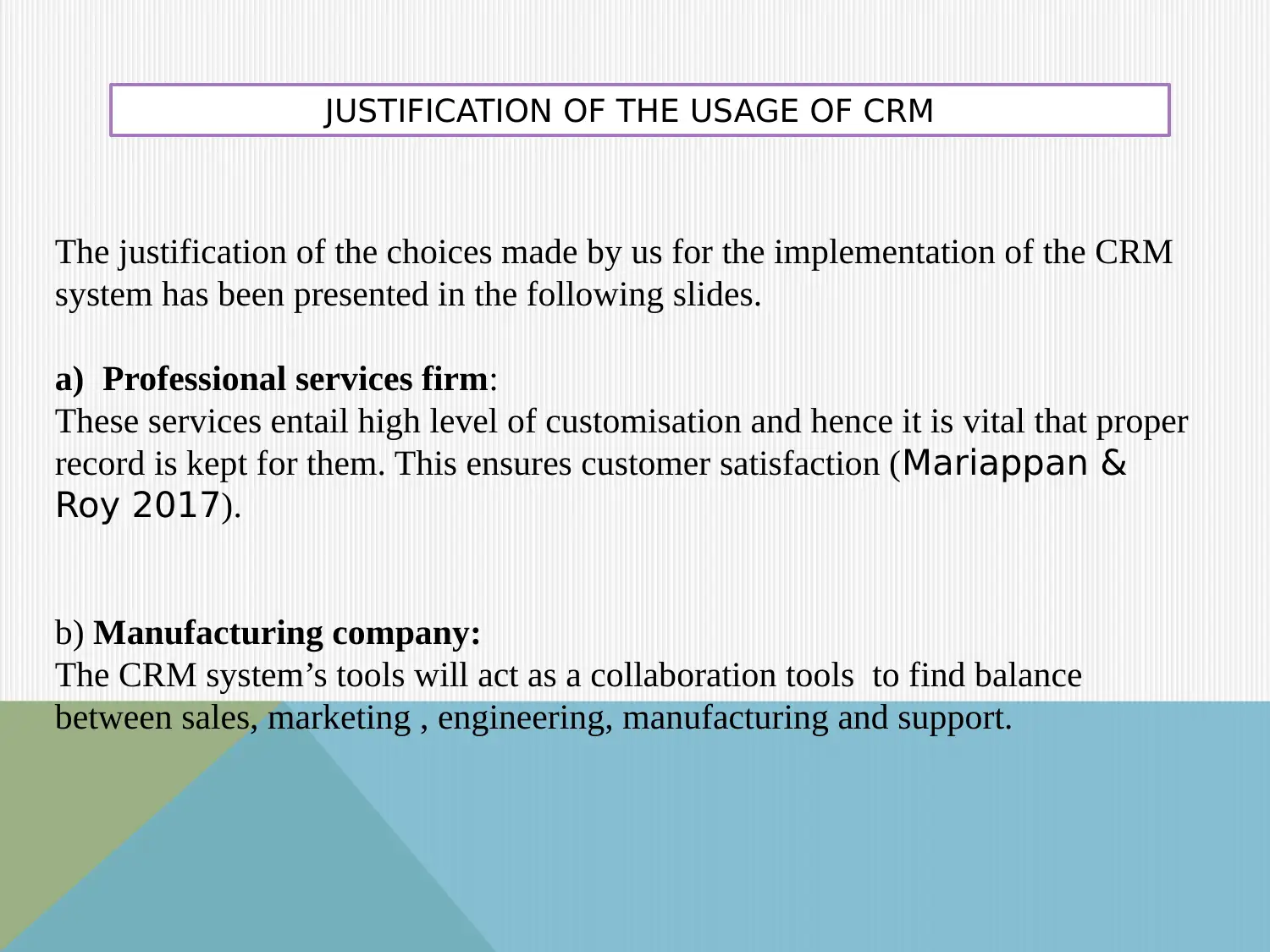
JUSTIFICATION OF THE USAGE OF CRM
The justification of the choices made by us for the implementation of the CRM
system has been presented in the following slides.
a) Professional services firm:
These services entail high level of customisation and hence it is vital that proper
record is kept for them. This ensures customer satisfaction (Mariappan &
Roy 2017).
b) Manufacturing company:
The CRM system’s tools will act as a collaboration tools to find balance
between sales, marketing , engineering, manufacturing and support.
The justification of the choices made by us for the implementation of the CRM
system has been presented in the following slides.
a) Professional services firm:
These services entail high level of customisation and hence it is vital that proper
record is kept for them. This ensures customer satisfaction (Mariappan &
Roy 2017).
b) Manufacturing company:
The CRM system’s tools will act as a collaboration tools to find balance
between sales, marketing , engineering, manufacturing and support.
⊘ This is a preview!⊘
Do you want full access?
Subscribe today to unlock all pages.

Trusted by 1+ million students worldwide
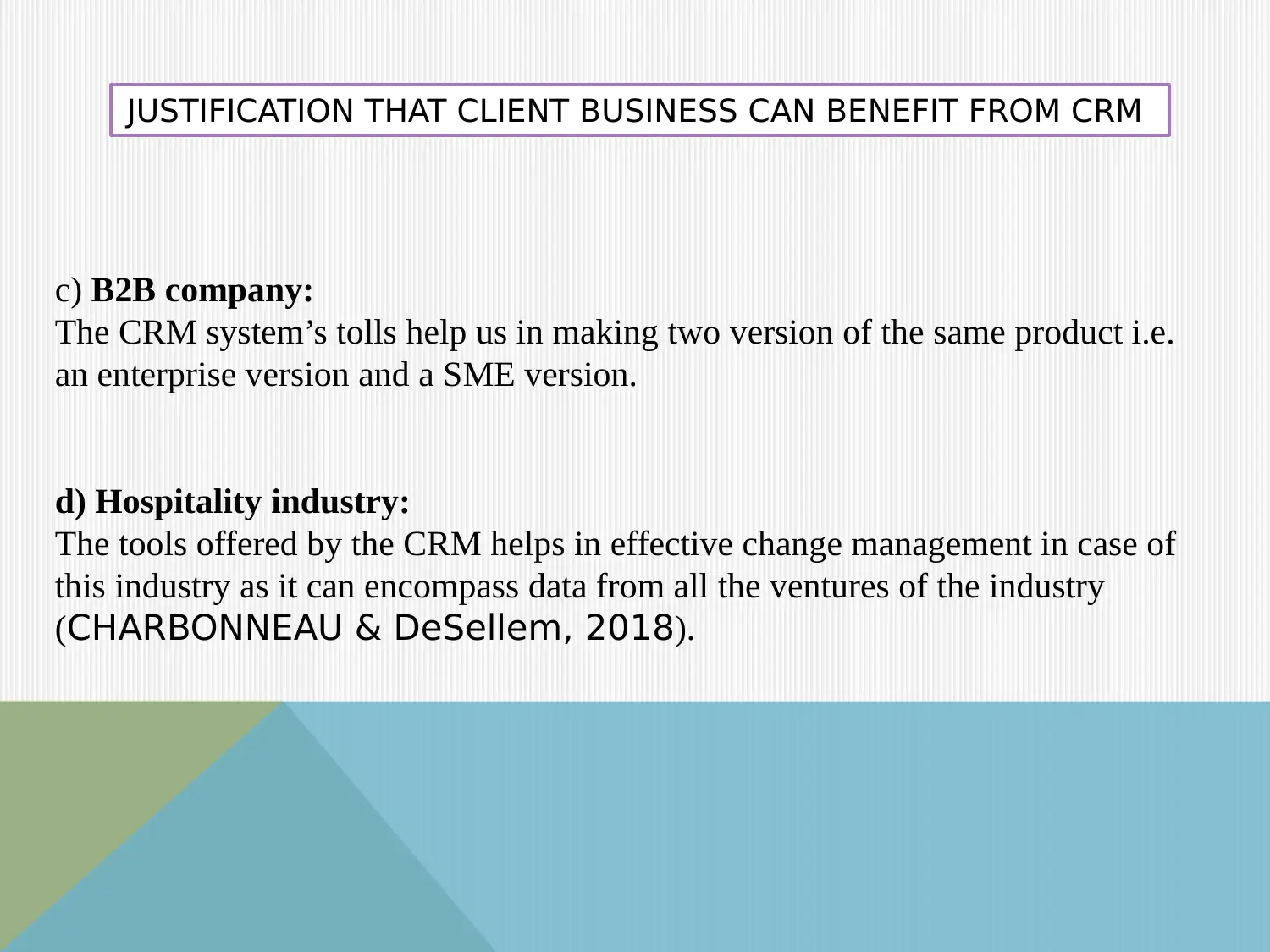
JUSTIFICATION THAT CLIENT BUSINESS CAN BENEFIT FROM CRM
c) B2B company:
The CRM system’s tolls help us in making two version of the same product i.e.
an enterprise version and a SME version.
d) Hospitality industry:
The tools offered by the CRM helps in effective change management in case of
this industry as it can encompass data from all the ventures of the industry
(CHARBONNEAU & DeSellem, 2018).
c) B2B company:
The CRM system’s tolls help us in making two version of the same product i.e.
an enterprise version and a SME version.
d) Hospitality industry:
The tools offered by the CRM helps in effective change management in case of
this industry as it can encompass data from all the ventures of the industry
(CHARBONNEAU & DeSellem, 2018).
Paraphrase This Document
Need a fresh take? Get an instant paraphrase of this document with our AI Paraphraser
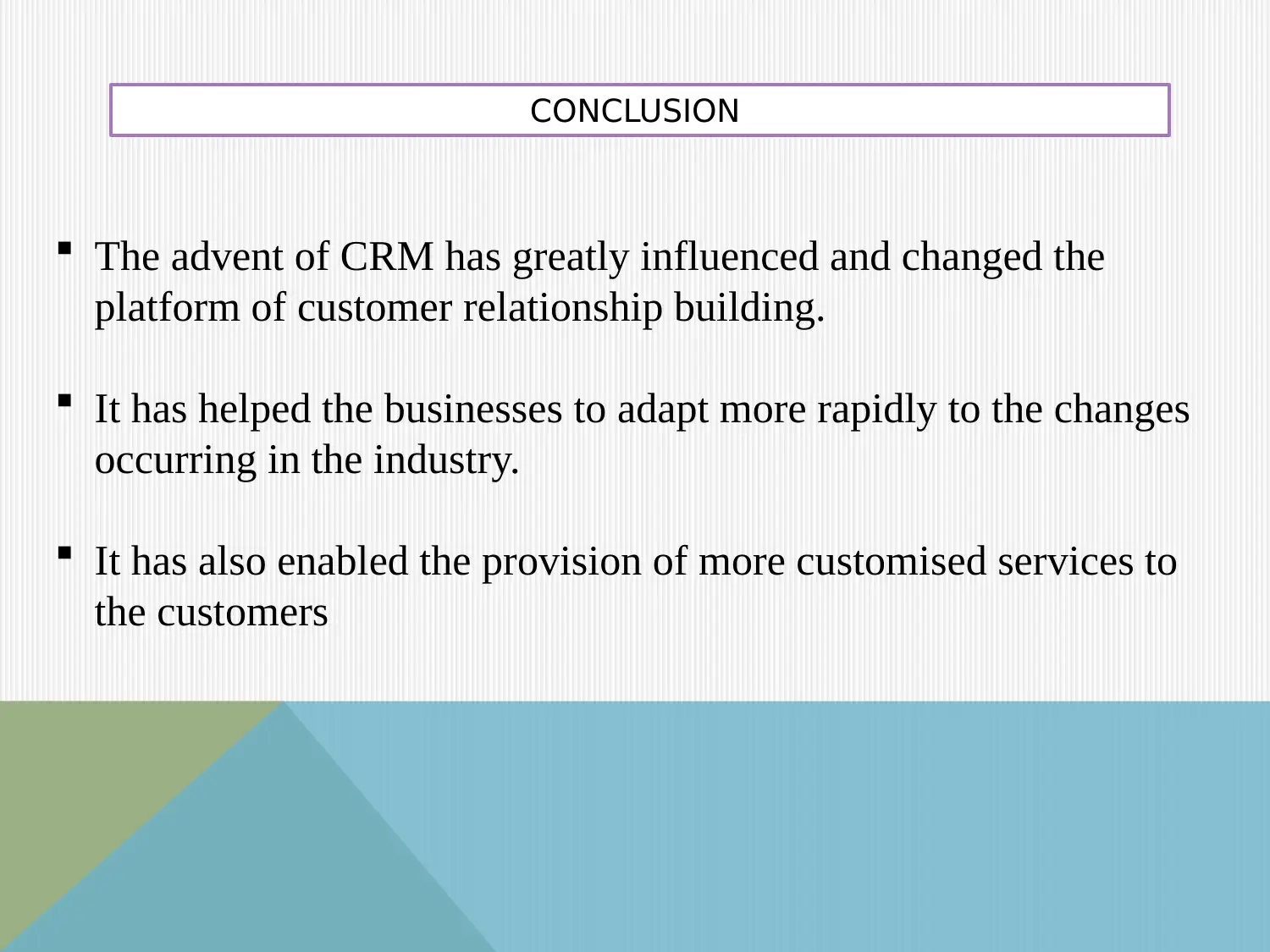
CONCLUSION
The advent of CRM has greatly influenced and changed the
platform of customer relationship building.
It has helped the businesses to adapt more rapidly to the changes
occurring in the industry.
It has also enabled the provision of more customised services to
the customers
The advent of CRM has greatly influenced and changed the
platform of customer relationship building.
It has helped the businesses to adapt more rapidly to the changes
occurring in the industry.
It has also enabled the provision of more customised services to
the customers
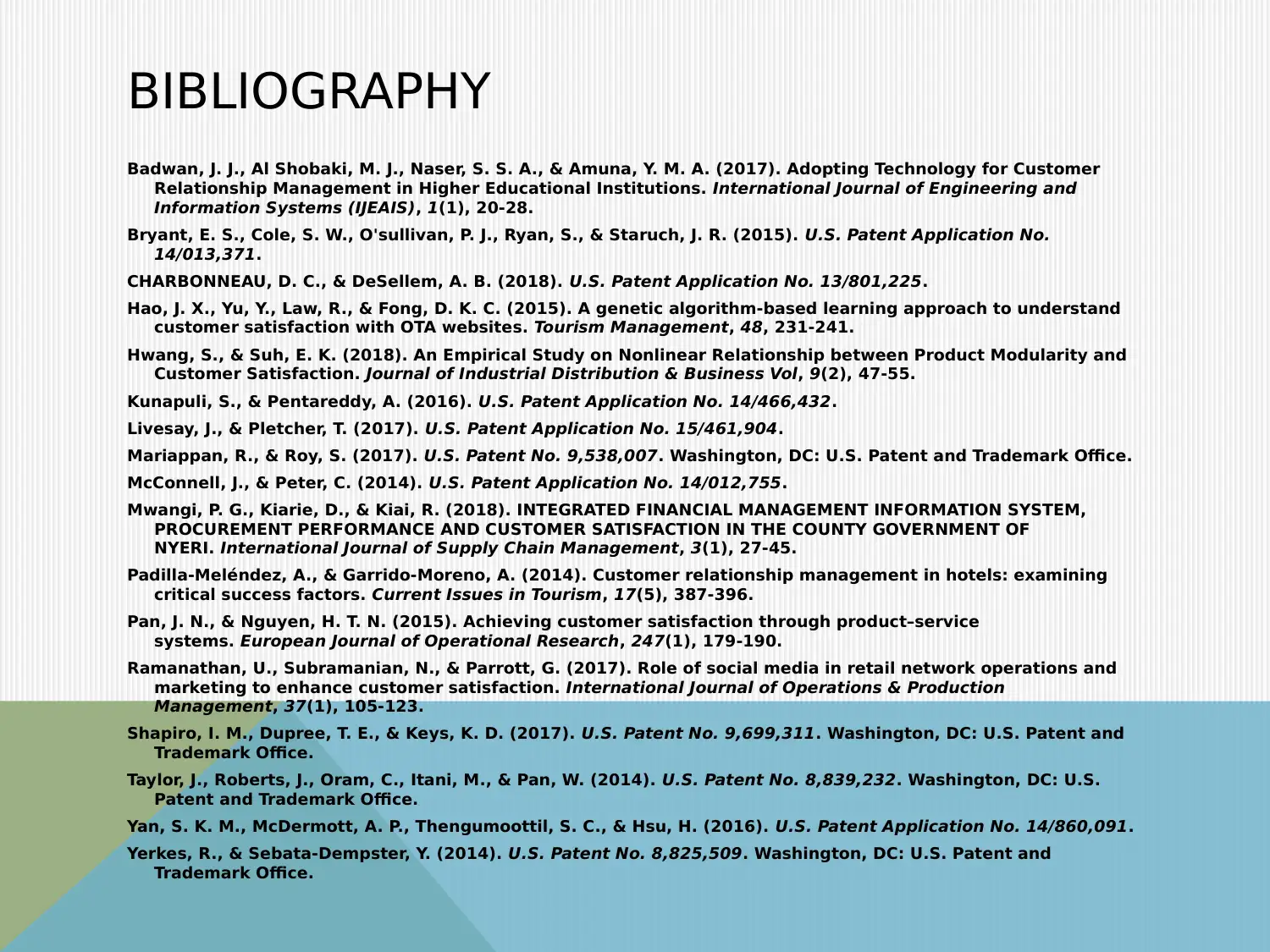
BIBLIOGRAPHY
Badwan, J. J., Al Shobaki, M. J., Naser, S. S. A., & Amuna, Y. M. A. (2017). Adopting Technology for Customer
Relationship Management in Higher Educational Institutions. International Journal of Engineering and
Information Systems (IJEAIS), 1(1), 20-28.
Bryant, E. S., Cole, S. W., O'sullivan, P. J., Ryan, S., & Staruch, J. R. (2015). U.S. Patent Application No.
14/013,371.
CHARBONNEAU, D. C., & DeSellem, A. B. (2018). U.S. Patent Application No. 13/801,225.
Hao, J. X., Yu, Y., Law, R., & Fong, D. K. C. (2015). A genetic algorithm-based learning approach to understand
customer satisfaction with OTA websites. Tourism Management, 48, 231-241.
Hwang, S., & Suh, E. K. (2018). An Empirical Study on Nonlinear Relationship between Product Modularity and
Customer Satisfaction. Journal of Industrial Distribution & Business Vol, 9(2), 47-55.
Kunapuli, S., & Pentareddy, A. (2016). U.S. Patent Application No. 14/466,432.
Livesay, J., & Pletcher, T. (2017). U.S. Patent Application No. 15/461,904.
Mariappan, R., & Roy, S. (2017). U.S. Patent No. 9,538,007. Washington, DC: U.S. Patent and Trademark Office.
McConnell, J., & Peter, C. (2014). U.S. Patent Application No. 14/012,755.
Mwangi, P. G., Kiarie, D., & Kiai, R. (2018). INTEGRATED FINANCIAL MANAGEMENT INFORMATION SYSTEM,
PROCUREMENT PERFORMANCE AND CUSTOMER SATISFACTION IN THE COUNTY GOVERNMENT OF
NYERI. International Journal of Supply Chain Management, 3(1), 27-45.
Padilla-Meléndez, A., & Garrido-Moreno, A. (2014). Customer relationship management in hotels: examining
critical success factors. Current Issues in Tourism, 17(5), 387-396.
Pan, J. N., & Nguyen, H. T. N. (2015). Achieving customer satisfaction through product–service
systems. European Journal of Operational Research, 247(1), 179-190.
Ramanathan, U., Subramanian, N., & Parrott, G. (2017). Role of social media in retail network operations and
marketing to enhance customer satisfaction. International Journal of Operations & Production
Management, 37(1), 105-123.
Shapiro, I. M., Dupree, T. E., & Keys, K. D. (2017). U.S. Patent No. 9,699,311. Washington, DC: U.S. Patent and
Trademark Office.
Taylor, J., Roberts, J., Oram, C., Itani, M., & Pan, W. (2014). U.S. Patent No. 8,839,232. Washington, DC: U.S.
Patent and Trademark Office.
Yan, S. K. M., McDermott, A. P., Thengumoottil, S. C., & Hsu, H. (2016). U.S. Patent Application No. 14/860,091.
Yerkes, R., & Sebata-Dempster, Y. (2014). U.S. Patent No. 8,825,509. Washington, DC: U.S. Patent and
Trademark Office.
Badwan, J. J., Al Shobaki, M. J., Naser, S. S. A., & Amuna, Y. M. A. (2017). Adopting Technology for Customer
Relationship Management in Higher Educational Institutions. International Journal of Engineering and
Information Systems (IJEAIS), 1(1), 20-28.
Bryant, E. S., Cole, S. W., O'sullivan, P. J., Ryan, S., & Staruch, J. R. (2015). U.S. Patent Application No.
14/013,371.
CHARBONNEAU, D. C., & DeSellem, A. B. (2018). U.S. Patent Application No. 13/801,225.
Hao, J. X., Yu, Y., Law, R., & Fong, D. K. C. (2015). A genetic algorithm-based learning approach to understand
customer satisfaction with OTA websites. Tourism Management, 48, 231-241.
Hwang, S., & Suh, E. K. (2018). An Empirical Study on Nonlinear Relationship between Product Modularity and
Customer Satisfaction. Journal of Industrial Distribution & Business Vol, 9(2), 47-55.
Kunapuli, S., & Pentareddy, A. (2016). U.S. Patent Application No. 14/466,432.
Livesay, J., & Pletcher, T. (2017). U.S. Patent Application No. 15/461,904.
Mariappan, R., & Roy, S. (2017). U.S. Patent No. 9,538,007. Washington, DC: U.S. Patent and Trademark Office.
McConnell, J., & Peter, C. (2014). U.S. Patent Application No. 14/012,755.
Mwangi, P. G., Kiarie, D., & Kiai, R. (2018). INTEGRATED FINANCIAL MANAGEMENT INFORMATION SYSTEM,
PROCUREMENT PERFORMANCE AND CUSTOMER SATISFACTION IN THE COUNTY GOVERNMENT OF
NYERI. International Journal of Supply Chain Management, 3(1), 27-45.
Padilla-Meléndez, A., & Garrido-Moreno, A. (2014). Customer relationship management in hotels: examining
critical success factors. Current Issues in Tourism, 17(5), 387-396.
Pan, J. N., & Nguyen, H. T. N. (2015). Achieving customer satisfaction through product–service
systems. European Journal of Operational Research, 247(1), 179-190.
Ramanathan, U., Subramanian, N., & Parrott, G. (2017). Role of social media in retail network operations and
marketing to enhance customer satisfaction. International Journal of Operations & Production
Management, 37(1), 105-123.
Shapiro, I. M., Dupree, T. E., & Keys, K. D. (2017). U.S. Patent No. 9,699,311. Washington, DC: U.S. Patent and
Trademark Office.
Taylor, J., Roberts, J., Oram, C., Itani, M., & Pan, W. (2014). U.S. Patent No. 8,839,232. Washington, DC: U.S.
Patent and Trademark Office.
Yan, S. K. M., McDermott, A. P., Thengumoottil, S. C., & Hsu, H. (2016). U.S. Patent Application No. 14/860,091.
Yerkes, R., & Sebata-Dempster, Y. (2014). U.S. Patent No. 8,825,509. Washington, DC: U.S. Patent and
Trademark Office.
⊘ This is a preview!⊘
Do you want full access?
Subscribe today to unlock all pages.

Trusted by 1+ million students worldwide
1 out of 12
Related Documents
Your All-in-One AI-Powered Toolkit for Academic Success.
+13062052269
info@desklib.com
Available 24*7 on WhatsApp / Email
![[object Object]](/_next/static/media/star-bottom.7253800d.svg)
Unlock your academic potential
Copyright © 2020–2025 A2Z Services. All Rights Reserved. Developed and managed by ZUCOL.




